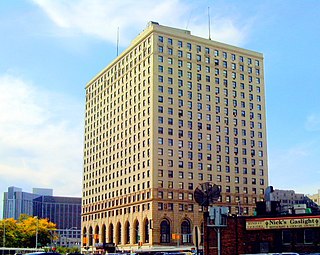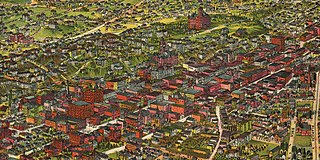
The Hollywood Hotel was a famous hotel, society venue of early Hollywood, and landmark, formerly located at 6811 Hollywood Boulevard, on the north side, extending from Highland Avenue to Orchid Avenue, in central Hollywood, Los Angeles, California.

Westlake, also known as the Westlake District, is a residential and commercial neighborhood in Central Los Angeles, California, United States. It was developed in the 1920s. Many of its elegant mansions have been turned into apartments and many new multiple-occupancy buildings have been constructed.
Bunker Hill is a neighborhood in Los Angeles, California. It is part of Downtown Los Angeles.

Criss Cross is a 1949 American film noir crime tragedy film starring Burt Lancaster, Yvonne De Carlo and Dan Duryea, directed by Robert Siodmak and written by Daniel Fuchs based on Don Tracy's 1934 novel of the same name. This black-and-white film was shot partly on location in the Bunker Hill section of Los Angeles. Miklós Rózsa scored the film's soundtrack.

Don Antonio Francisco Coronel was a Californio politician and ranchero who was Mayor of Los Angeles and California State Treasurer. Coronel was considered one of the first preservationists in Los Angeles, and his private collection formed the basis of the Natural History Museum of Los Angeles County.

El Cortez, a hotel and casino, is a relatively small downtown Las Vegas gaming venue a block from the Fremont Street Experience and Las Vegas Boulevard. Slots, table games, and a race and sports book occupy one floor of the main pavilion, at this historic casino. It opened on Fremont Street on November 7, 1941, and is one of the oldest casino-hotel properties in Las Vegas, along with the nearby Golden Gate Hotel and Casino. Primarily Spanish Colonial Revival in style, it reflects a 1952 remodel when the façade was modernized. On February 22, 2013, the structure was placed on the National Register of Historic Places.

The Detroit-Leland Hotel is a historic hotel located at 400 Bagley Street in Downtown Detroit, Michigan. It is the oldest continuously operating hotel in downtown Detroit, and was listed on the National Register of Historic Places in 2005. The ballroom of the Detroit-Leland has hosted a nightclub, the Leland City Club, since 1983. The hotel is now named The Leland and no longer rents to overnight guests.

The Hollywood Roosevelt Hotel, also known as Hotel Roosevelt, is a historic hotel located at 7000 Hollywood Boulevard in the Hollywood district of Los Angeles, California.
George Albert Ralphs was an American businessman. He founded the Ralphs supermarket chain in Southern California, with the help of his brother Walter.

The Hotel Alexandria is a historic building constructed as a luxury hotel at the beginning of the 20th century in what was then the heart of downtown Los Angeles. As the business center of the city moved gradually westward, the hotel decayed and gradually devolved into a single-room occupancy (SRO) hotel housing long-term, low income residents and gained a reputation for crime and being unsafe. Revitalization of the area in the 21st century changed the rental practices and neighborhood safety.
Thomas Pascoe (1847–1938) was an Englishman who initially worked in the Royal Navy for seven years and also witnessed the opening of the Suez canal. After he left the naval service, he migrated to the United States, where he became a hotel developer and proprietor in California.

The Blackstone Building is a 1916 structure located at 901 South Broadway in Los Angeles, California. It has been listed as a Los Angeles Historic-Cultural Monument since 2003. The Blackstone Department Store Building is an early example of the work of John B. Parkinson, Los Angeles’ preeminent architect of the early 20th century, who also designed Bullocks Wilshire. The building is clad in gray terra cotta and styled in the Beaux Arts school.

Bimini Baths was a geothermal mineral water public bathhouse and plunge in what is now Koreatown, Los Angeles, California, US. It was situated just west of downtown, near Third Street and Vermont Avenue. Bimini Baths contained a natatorium, swimming pools, swimming plunge, Turkish baths, a medical treatment department, and bottling works.

Margaret Jane Anderson was an American hotel owner, businesswomen, and socialite, from the U.S. state of Iowa. The widow of Lewis Anderson, she was the owner and developer of two properties in Los Angeles County, California: The Beverly Hills Hotel and the Hollywood Hotel.

Hollywood Plaza Hotel, also known as Plaza Hotel, was a 200-room hotel located at 1633–37 North Vine Street in Hollywood, California, just south of Hollywood and Vine. A popular venue for film, radio, and theatre stars of the 1930s, 1940s, and 1950s, the building was converted into a retirement home in the 1970s.

The late-Victorian-era Downtown of Los Angeles in 1880 was centered at the southern end of the Los Angeles Plaza area, and over the next two decades, it extended south and west along Main Street, Spring Street, and Broadway towards Third Street. Most of the 19th-century buildings no longer exist, surviving only in the Plaza area or south of Second Street. The rest were demolished to make way for the Civic Center district with City Hall, numerous courthouses, and other municipal, county, state and federal buildings, and Times Mirror Square. This article covers that area, between the Plaza, 3rd St., Los Angeles St., and Broadway, during the period 1880 through the period of demolition (1920s–1950s).

Cable car street railways first began operating in Los Angeles in 1885 and lasted until 1902, when the lines were electrified and electric streetcars were introduced largely following the cable car routes. There were roughly 25 miles (40 km) of routes, connecting 1st and Main in what was then the Los Angeles Central Business District as far as the communities known today as Lincoln Heights, Echo Park/Filipinotown, and the Pico-Union district.

Hotel Lankershim was a landmark hotel located at 7th Street and Broadway in the Broadway Theater District in downtown Los Angeles's historic core.

The Arlington Hotel was a historic hotel in Santa Barbara, California, United States. Opened in 1876, it was one of the grandest hotels in the West. The original building burned down on 15 August 1909, and a replacement hotel was completed in 1911 at a cost of over one and a half million dollars. This building suffered further misfortune when a strong earthquake devastated the town in 1925, and the hotel was left in ruins.

The Hotel Arcadia was a hotel in Santa Monica, California that stood on the oceanfront between 1886 and 1909. The hotel was located on Ocean Avenue between Colorado and Front.



















